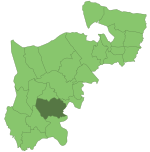Hounslow power station
Buildings and structures in the London Borough of HounslowCoal-fired power stations in EnglandDemolished power stations in the United Kingdom
Hounslow power station generated and supplied electricity to the district of Hounslow, Heston and Isleworth in west London from 1904 to 1964. Originally steam powered, diesel engine generators were added in the 1950s.The station was owned and operated by Heston and Isleworth Borough Council until the nationalisation of the electricity industry in 1948. The power station was redeveloped as demand for electricity grew and old plant was replaced until its closure in 1964.
Excerpt from the Wikipedia article Hounslow power station (License: CC BY-SA 3.0, Authors).Hounslow power station
Bridge Road, London Worton (London Borough of Hounslow)
Geographical coordinates (GPS) Address Nearby Places Show on map
Geographical coordinates (GPS)
| Latitude | Longitude |
|---|---|
| N 51.469444444444 ° | E -0.34805555555556 ° |
Address
Bridge Road
Bridge Road
TW3 1SG London, Worton (London Borough of Hounslow)
England, United Kingdom
Open on Google Maps




